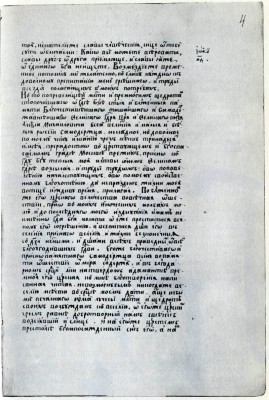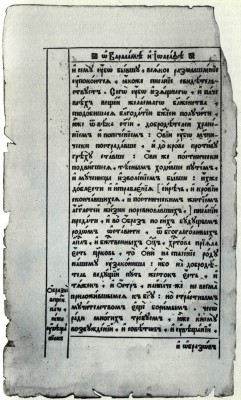Simeon of Polotsk
The founder of an unbroken tradition of syllabic poetry in Moscow was the Byelorussian’ Samuil Sitnianovich-Petrovsky (1629-1680), who at the age of twenty-seven took monastic vows and the name of Simeon and became known in Moscow as Simeon of Polotsk, his native town where he had tought in the school of the Orthodox “fraternity” there. In the summer and autumn of 1656 the young teacher had the opportunity of attracting the attention of Tsar Alexis. The tsar visited the Russian army units stationed outside Riga and twice stayed at Polotsk where he heard welcoming verses composed by Simeon. In 1660 Simeon visited Moscow, again presenting the tsar with his verses. A year later Polotsk was captured by the Poles, and in 1664 Simeon moved to Moscow, this time to stay.
Thus, at the source of Baroque stood an Orthodox Byelorussian, who had studied the “seven free arts” in the Kiev-Mogila Academy and may have attended a course of lectures at the VilnaJesuitAcademy, the best educational establishment of the so-called “Lithuanian province” of the Jesuit Order and the only one of its kind. The origins and education of Simeon of Polotsk show clearly whence and how the Baroque style came to Russia.
In Moscow Simeon of Polotsk continued the profession of teacher begun in his native land.63 He educated the tsar’s children (one of whom, the future Tsar Theodore, he taught to write syllabic verse), and opened a Latin school not far from the Kremlin in the Monastery Behind the Icon of the Saviour, where the young scribes of the Privy Office, Tsar Alexis’ own chancery, studied. Simeon of Polotsk also set up and held another post, that of court poet, which had hitherto been unknown in Russia. Any event in the tsar’s family, such as marriages, saint’s days, and births, gave Simeon of Polotsk an opportunity to write verses “for the occasion”. These verses, which belong to the silva genre, were collected by the poet towards the end of his life in the huge Rhymologian (which has survived in draft form and been published in extracts only).
Simeon of Polotsk’s heritage is very big. It is estimated that he left at least fifty thousand lines of poetry.64

Introduction in prose to The Garden of Many Flowers by Simeon of Polotsk. 1670s-1680s. Academy of Sciences Library, Leningrad
Apart from The Rhymologian, there are The Rhyming Psalter (a verse rendering of the Psalter, printed in 1680) and the vast collection, as yet unpublished, entitled The Garden of Many Flowers (1678), a kind of poetic encyclopaedia in which the verses are arranged in alphabetical order. The Garden of Many Flowers contains 1,155 headings, a single heading sometimes comprising a whole cycle, from two to twelve poems.
From an account by Sylvester Medvedev (1641-1691), a pupil and favourite of Simeon of Polotsk, we know how the latter worked. In the Monastery Behind the Icon of the Saviour the teacher and his pupil lived in neighbouring rooms connected by a common lobby. Sylvester Medvedev, a constant eyewitness of Simeon’s work, recalled that the latter “was in the habit of writing half-a-quire of quarto each day, and his handwriting was very small and compact”, i.e., each day he covered eight pages of quarto paper with small handwriting. This prolific output was not graphomania; it reflected Simeon of Polotsk’s main creative aim. As a European-oriented person, he did not rate Old Russian literature very highly. He believed that his task was to create a new literary culture for Russia.
Such a culture needed readers capable of appreciating and understanding it. Well aware that these readers would have to be trained, Simeon of Polotsk sought to “inundate” life at the tsar’s court and among the aristocracy of the capital with syllabic verse. On public holidays his verses in the genres of the “recitation” and “dialogue” were read in public by the author himself and specially trained youths. His panegyrics were also read in public. Judging from the composition of The Rhymologian and from the author’s notes in the margin, Simeon of Polotsk took advantage of every possible occasion to deliver speeches in verse. He composed these speeches both for himself and for others, commissioned or as a present. They were read at official royal banquets, in boyars’ chambers and in church during festivals.
The Garden of Many Flowers was a different sort of work. It was an encyclopaedia of poetry in which Simeon of Polotsk sought to give the reader a broad range of knowledge, first and foremost, on antique and mediaeval West European history. Here we find mythological subjects and historical anecdotes about Caesar, Augustus, Alexander the Great, Diogenes, Justinian and Charlemagne. In many poems he makes use of Pliny the Elder’s Natural History. The Garden of Many Flowers provides information on fantastic and exotic creatures, the phoenix, the crocodile, the ostrich, precious stones, etc. Here we also find an exposition of cosmogonic views and excursions into the sphere of Christian symbolism. In the words of Igor Eremin, the poems of The Garden “create the impression of an unusual museum, in whose show-cases all manner of things, often rare and very old, are arranged in a set order… Everything that Simeon, the well-read bibliophile and lover of ‘rarities’ and ‘curiosities’, managed to collect in his memory throughout his life is displayed here for inspection.” 65
This “museum of rarities” reflects some of the basic motifs of Baroque, first and foremost, the idea of the “variety” of the world, the inconstancy of all things, and also the penchant for the sensational that is typical of Baroque. However, the unusual feature about this “museum” is that it is a museum of letters. Simeon of Polotsk sees the development of culture as a kind of verbal procession, a parade of words.
At first glance objects too appear to take part in this procession. But Simeon of Polotsk is not interested in the sphinx and the salamander, the phoenix and the siren, the pelican and the centaur, the magnet or amber, as such. It is only their cognisable essence, the word concealed in them, that interests him, for he is convinced that the word is the main element in culture.
According to his point of view, the poet is a “second God”: just as God made the world with the Word, so the poet with his word conjures up people, events and ideas out of non-being. Simeon sees the world in the form of a book or alphabet, and the elements of the world as parts of the book, its pages, lines, words, type:
Мир сей преукрашенный — книга есть велика,
ежесловом написа всяческих владыка.
Пять листов препространных в ней ся обретают,
яже чюдна писмена в себе заключают.
Первый же лист есть небо, на нем же святила,
яко писмена, божия крепость положила.
Второй лист огнь стихийный под небом высоко,
в нем яко писание силу да зрит око.
Третий лист преширокий аер мощно звати,
на нем дождь, снег, облаки и птицы читати.
Четвертый лист — сонм водный в ней ся обретает,
в том животных множество удобь ся читает.
Последний лист есть земля с древесы, с травами,
с крушцы и с животными, яко с письменами.
This finely adorned world is a great book,/That the Lord of all wrote with the Word./In it there are five vast sheets/Containing within them wondrous letters./
The first sheet is the heavens on which the Divine power/Hath placed heavenly bodies like letters./The second sheet is the fire of the elements that covers/The heavens and appears to the eye as writing./The third sheet we can call the broad ether/And read rain, snow, clouds and birds upon it./The fourth sheet is the watery element, in which/We can easily read many living creatures./The last sheet is the earth with trees, grasses,/Ores and beasts like letters.
The word was seen as the instrument for transforming the world, a means of creating a new, European culture. Consequently Simeon of Polotsk’s plans for enlightenment were, first and foremost, the plans of a humanitarian. It was Sylvester Medvedev who sought to implement these plans in the 1680s.
 History of Russian Literature
History of Russian Literature

